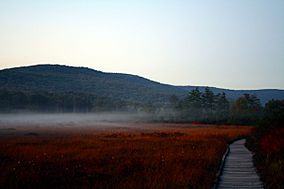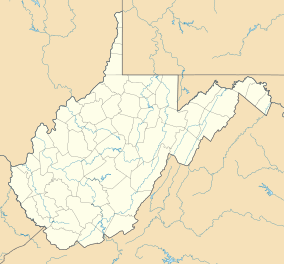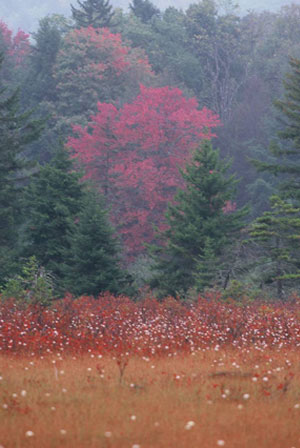Cranberry Glades facts for kids
Quick facts for kids Cranberry Glades |
|
|---|---|

Fog over Cranberry Glades boardwalk
|
|
| Location | Pocahontas, West Virginia, United States |
| Area | 750 acres (300 ha) |
| Elevation | 3,400 ft (1,000 m) |
| Operator | Monongahela National Forest |
| Website | Cranberry Glades Botanical Area |
Cranberry Glades, also known as The Glades, is a special natural area in Pocahontas County, West Virginia. It is made up of five small bogs. A bog is a type of wetland with very wet, spongy ground and unique plants. These bogs are like those found in colder, northern places such as Canada.
The Glades are high up in the Allegheny Mountains, about 3,400 feet (1,036 meters) above sea level. This area is protected as the Cranberry Glades Botanical Area. It is part of the Monongahela National Forest. The Glades are also where the Cranberry River begins. This river is famous for trout fishing.
This protected area covers about 750 acres (3.0 km²). The soil here is very acidic. This allows special plants to grow that usually live in colder climates. You can find cranberries, sphagnum moss, skunk cabbage, and even two types of carnivorous plants. These include the purple pitcher plant and sundew. For many of these plants, Cranberry Glades is the southernmost place they grow.
Scientists have studied Cranberry Glades for many years. In 1974, it was named a National Natural Landmark. This means it is a very important natural site.
What are Cranberry Glades?
The Glades are not just open fields. They are a type of wetland or bog. The ground is covered with thick, decaying plants. This creates a spongy surface. Underneath, the peat (decaying plant matter) can be more than ten feet thick.
The Glades sit in a high valley. It is surrounded by the Cranberry, Kennison, and Black Mountains. This creates a bowl-like shape. In 1911, five separate glades were identified and named:
- Big Glade (59 acres)
- Flag Glade (28 acres)
- Long Glade (20 acres)
- Round Glade (8 acres)
- Little Glade (1 acre)
Little Glade, the smallest one, has since been covered by plants. It is no longer easy to see.
How the Glades Formed
The natural history of Cranberry Glades goes back over 12,200 years. After the last Ice Age, a forest of conifer and northern hardwood trees grew here. Over time, the Glades slowly changed into what they are today.
Scientists believe the Glades formed because of the types of rocks in the area. Some rocks eroded easily, creating a basin. Other, stronger rocks at the lower end kept water from flowing out too quickly. This helped the bogs to form and stay wet.
The water from the Glades flows into the Cranberry River. This river starts high up in the mountains. It then winds through the Glades. Finally, it joins the Gauley River about 25 miles (40 km) downstream.
Plants and Animals
The plants and animals in Cranberry Glades are very special. Many of them are usually found much farther north. They are like living reminders of the last Ice Age.
Unique Plants
Many plants here are descendants of seeds that took root over ten thousand years ago. Two very unusual plants are the carnivorous plants. These are the purple pitcher plant and the native sundew. They eat insects because the spongy soil does not have enough nutrients for their roots.
Other rare plants include bog rosemary and buckbean. These are found in the Big Glade. The area is also home to many types of mosses. These include sphagnum moss, bird-wheat moss, and reindeer lichen. These mosses can form tall mounds called Hummocks, up to 3 feet (0.91 m) high. Cranberry vines grow over these mosses. They have pink flowers in summer and red fruits in late September.
Trees in the Glades
The "bog forest" part of the Glades has many trees. These include red spruce, eastern hemlock, yellow birch, and red maple. The forests around the wetlands have these same trees. They also have American beech, sugar maple, black cherry, and other types of trees.
Shrubs and Bushes
The Glades have many different kinds of shrubs. These woody plants grow in the open areas and along streams. Common shrubs include speckled alder, willow, great rhododendron, and winterberry holly. Many of these shrubs are usually found in northern regions. For example, bog rosemary and oblongfruited serviceberry are at their southernmost limit here.
The Canada yew is an evergreen shrub that used to be common. However, deer eating them has made them rare. Yew Creek, nearby, might even be named after this plant.
Small Plants and Flowers
Many small plants, called herbs, also grow here. These include oak fern, Canada mayflower, marsh marigold, and northern white violet. Some, like Jacob's ladder, are at their southernmost location.
Different types of grasses and sedges grow here too. Wild lilies like yellow clintonia are also found. Several kinds of orchids bloom in July. These include the rose pogonia and grass-pink orchid. The northern coralroot orchid is likely at its southernmost spot in the eastern United States.
Animals of the Glades
Many animals in Cranberry Glades also live at their southernmost breeding grounds. This includes birds like the Swainson’s and hermit thrushes. You might also see Nashville and mourning warblers, and purple finches. Other common birds are ravens and hawks.
Familiar animals like whitetail deer live in the Glades. Black bears have been seen near the boardwalk. If you visit in the evening, you might hear beavers working. They are usually busy building their homes at night.
Weather in the Glades
Cranberry Glades is known for its changing weather. This is common for areas high in the Alleghenies. The area is generally cool and wet. Its climate is similar to places in New England or Canada.
The high mountains around the Glades create a bowl shape. This causes cool air to drain down into the Glades. Because of the high elevation, it can even frost any time of year. The frost-free period can be as short as 81 days in some years.
In summer, the average high temperature is around 74–82 °F (23–28 °C). In winter, temperatures can drop as low as -26 °F (-32 °C). The area also gets a lot of snow.
Visiting Cranberry Glades
Today, Cranberry Glades is a popular stop along the Highland Scenic Highway. Near the Glades, you can visit the Cranberry Mountain Nature Center. This center offers information about the area.
Inside the Glades, the Monongahela National Forest has built a 0.5-mile (0.80 km) boardwalk. This boardwalk lets visitors walk safely along the edge of some bogs and through a small wooded area. There is also a 6.0-mile (9.7 km) hiking path called Cowpasture Trail. This trail marks the border between the Cranberry Glades Botanical Area and the larger Cranberry Wilderness.
Because the area is very sensitive, visitors must stay on these paths. This helps protect the unique plants and animals that live here.
Images for kids




